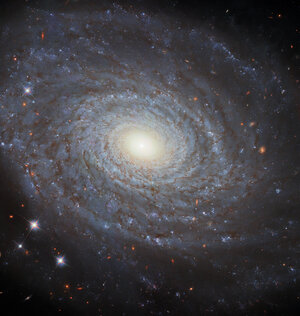Accept all cookies Accept only essential cookies See our Cookie Notice

About ESA
The European Space Agency (ESA) is Europe’s gateway to space. Its mission is to shape the development of Europe’s space capability and ensure that investment in space continues to deliver benefits to the citizens of Europe and the world.
Highlights
ESA - United space in Europe
This is ESA ESA facts Member States & Cooperating States Funding Director General Top management For Member State Delegations European vision European Space Policy ESA & EU Space Councils Responsibility & Sustainability Annual Report Calendar of meetings Corporate newsEstablishments & sites
ESA Headquarters ESA ESTEC ESA ESOC ESA ESRIN ESA EAC ESA ESAC Europe's Spaceport ESA ESEC ESA ECSAT Brussels Office Washington OfficeWorking with ESA
Business with ESA ESA Commercialisation Gateway Law at ESA Careers Cyber resilience at ESA IT at ESA Newsroom Partnerships Merchandising Licence Education Open Space Innovation Platform Integrity and Reporting Administrative Tribunal Health and SafetyMore about ESA
History ESA Historical Archives Exhibitions Publications Art & Culture ESA Merchandise Kids Diversity ESA Brand Centre ESA ChampionsSpace in Member States
Find out more about space activities in our 23 Member States, and understand how ESA works together with their national agencies, institutions and organisations.
Science & Exploration
Exploring our Solar System and unlocking the secrets of the Universe
Go to topicAstronauts
Missions
Juice Euclid Webb Solar Orbiter BepiColombo Gaia ExoMars Cheops Exoplanet missions More missionsActivities
International Space Station Orion service module Gateway Concordia Caves & Pangaea BenefitsLatest
Space Safety
Protecting life and infrastructure on Earth and in orbit
Go to topicAsteroids
Asteroids and Planetary Defence Asteroid danger explained Flyeye telescope: asteroid detection Hera mission: asteroid deflection Near-Earth Object Coordination CentreSpace junk
About space debris Space debris by the numbers Space Environment Report In space refuelling, refurbishing and removingSafety from space
Clean Space ecodesign Zero Debris Technologies Space for Earth Supporting Sustainable DevelopmentApplications
Using space to benefit citizens and meet future challenges on Earth
Go to topicObserving the Earth
Observing the Earth Future EO Copernicus Meteorology Space for our climate Satellite missionsCommercialisation
ESA Commercialisation Gateway Open Space Innovation Platform Business Incubation ESA Space SolutionsLatest
Enabling & Support
Making space accessible and developing the technologies for the future
Go to topicBuilding missions
Space Engineering and Technology Test centre Laboratories Concurrent Design Facility Preparing for the future Shaping the Future Discovery and Preparation Advanced Concepts TeamSpace transportation
Space Transportation Ariane Vega Space Rider Future space transportation Boost! Europe's Spaceport Launches from Europe's Spaceport from 2012Latest

Colouring what human eyes can’t see
Thank you for liking
You have already liked this page, you can only like it once!
If the Hubble Picture of the Week from two weeks ago was somewhat dim and subtle in appearance, then this week’s image is a veritable riot of colour and activity! It features a relatively close-by star-forming region known as IRAS 16562-3959 that lies within the Milky Way in the constellation Scorpius, about 5900 light-years from Earth.
This image was compiled using observations from Hubble’s Wide Field Camera 3 (WFC 3). The detailed nuances of colour are possible because of the four separate filters that were used to collect the data. Filters are thin slivers of highly specialised material that only allow very specific wavelengths of light through. They can be slid in front of the part of the telescope that is sensitive to light, letting astronomers control which wavelengths of light the telescope collects with each observation. This is useful not only for specific scientific research, but also for the creation of images like this one.
Raw telescope observations are always monochrome, regardless of which filter was used. However, specially trained artists and image specialists can select colours that match the wavelength range covered by individual filters. Or, in the case where a direct match is not possible — such as for the data used in this image, which are all in the infrared regime, which human eyes are not sensitive to — the artist can select a colour that sensibly represents what is taking place. For example, they might assign bluer colours to shorter wavelengths and redder colours to longer wavelengths, as is the case in the visible light range. Then, data from multiple filters can be combined to build up a multi-colour image, that both looks beautiful and has scientific meaning.
At the centre of the image, IRAS 16562-3959 is thought to host a massive star — about 30 times the mass of our Sun — that is still in the process of forming. At the near-infrared wavelengths to which Hubble is sensitive, the central region appears dark because there is so much obscuring dust in the way. However near-infrared light leaks out mainly on two sides — upper left and lower right — where a powerful jet from the massive protostar has cleared away the dust. Multi-wavelength images including this incredible Hubble scene will help us gain a better understanding of how the most massive, brightest stars in our galaxy are born.
[Image Description: A nebula with stars. The centre of the image from top-left to bottom-right glows brightly with light from where new stars are being formed, and is partially covered by dark dust. Coloured layers of gas and dust billow out across the rest of the image. The nebula is speckled with foreground stars with large diffraction spikes.]
-
CREDIT
ESA/Hubble & NASA, R. Fedriani, J. Tan; CC BY 4.0 -
LICENCE
CC BY 4.0 INT or ESA Standard Licence
(content can be used under either licence)

Eye of the galaxy

Colourful clouds of a nearby neighbour

Four filter fusion

Same galaxy, different filters















 Germany
Germany
 Austria
Austria
 Belgium
Belgium
 Denmark
Denmark
 Spain
Spain
 Estonia
Estonia
 Finland
Finland
 France
France
 Greece
Greece
 Hungary
Hungary
 Ireland
Ireland
 Italy
Italy
 Luxembourg
Luxembourg
 Norway
Norway
 The Netherlands
The Netherlands
 Poland
Poland
 Portugal
Portugal
 Czechia
Czechia
 Romania
Romania
 United Kingdom
United Kingdom
 Slovenia
Slovenia
 Sweden
Sweden
 Switzerland
Switzerland
























